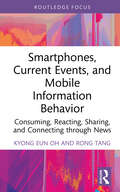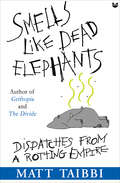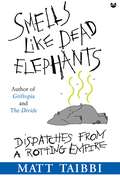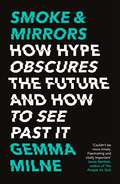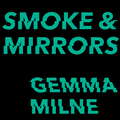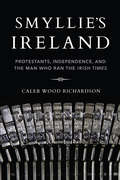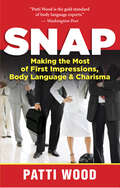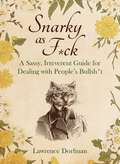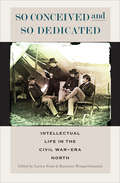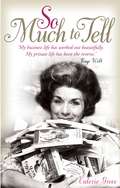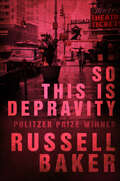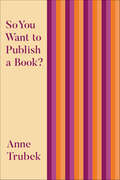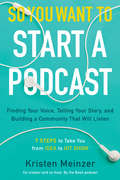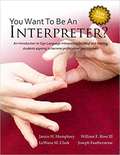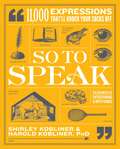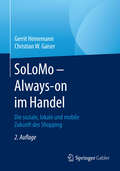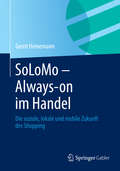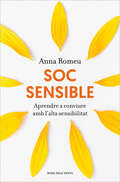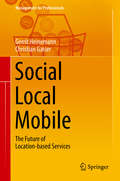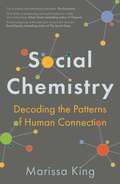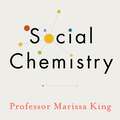- Table View
- List View
Smartphones, Current Events and Mobile Information Behavior: Consuming, Reacting, Sharing, and Connecting through News
by Kyong Eun Oh Rong TangSmartphones and Information on Current Events provides unprecedented insights into young people’s news consumption patterns and the ecology of mobile news. Advancing our knowledge of mobile behaviour, the book also highlights the ways in which mobile news impacts the lives of the general public. Using a multi-faceted research model on mobile news consumption behaviour, Oh and Tang examined a wide spectrum of mobile news consumption activities, outlined the key characteristics of mobile news, as well as captured users’ near real-time evaluation of and emotional reactions to news stories. The book also shows that the process of using smartphones to receive, read, find, share, and store news stories has resulted in new behavioural patterns that enable people to consume news in a multifaceted way. Analyzing the extent and various methods of mobile news sharing can, Oh and Tang argue, help us understand how such exchanges reshape contemporary society. Demonstrating that mobile news consumption is now an integral part of people’s daily lives, the book clearly shows that its impact on people’s day-to-day activities, and their political and social lives, cannot be underestimated. Smartphones and Information on Current Events will be useful to scholars, students, and practitioners who are studying library and information science, journalism and media, digital communication, user behaviour, information technology, human-computer interaction, marketing, political science, psychology, and sociology.
Smells Like Dead Elephants: Dispatches from a Rotting Empire
by Matt TaibbiSmells Like Dead Elephants is a brilliant collection from Matt Taibbi, a political reporter with the gonzo spirit that made Hunter S. Thompson and P. J. O’Rourke so much fun” (The Washington Post). Bringing together Taibbi’s most incisive and hilarious work from his Road Work” column in Rolling Stone, Smells Like Dead Elephants shines an unflinching spotlight on the corruption, dishonesty, and sheer laziness of our leaders. Taibbi has plenty to say about George W. Bush, Jack Abramoff, Tom DeLay, and all the rest, but he doesn’t just hit inside the Beltway. He gets involved in the action, infiltrating Senator Conrad Burns’s birthday party under disguise as a lobbyist for a fictional oil firm that wants to drill in the Grand Canyon. He floats into apocalyptic post-Katrina New Orleans in a dinghy with Sean Penn. He goes to Iraq as an embedded reporter, where he witnesses the mind-boggling dysfunction of our occupation and spends three nights in Abu Ghraib prison. And he reports from two of the most bizarre and telling trials in recent memory: California v. Michael Jackson and the evolution-vs.-intelligent-design trial in Harrisburg, Pennsylvania. Equally funny and shocking, this is excellent work from one of our most entertaining writers.
Smells like Dead Elephants: Dispatches from a Rotting Empire
by Matt TaibbiMatt Taibbi is notorious as a journalistic agitator, a stone thrower, a "natural provocateur" (Salon. com). His scathing, vibrant prose shines an unflinching spotlight on the corruption, dishonesty, and sheer laziness of our leaders. Smells Like Dead Elephants brings together Taibbi's most incisive, intense, and hilarious work from his "Road Work" column in Rolling Stone. Written over the last two years, a period in our history with no shortage of outrages to compel Taibbi's pen, these pieces paint a shocking portrait of our government at work--or, as Taibbi points out in "The Worst Congress Ever," rarely working. "In the Sixties and Seventies, Congress met an average of 162 days a year. The 109th Congress set the all-time record for fewest days worked by a U.S. Congress: 93. Figuring for half-days, in fact, the 109th Congress probably worked almost two months less than the notorious 'Do-Nothing' Congress of 1948". Taibbi has plenty to say about George W. Bush, Jack Abramoff, Tom DeLay, and all the rest, but he doesn't just hit inside the Beltway. He gets involved in the action, infiltrating Senator Conrad Burns's birthday party under disguise as a lobbyist for a fictional oil firm that wants to drill in the Grand Canyon. He floats into apocalyptic post-Katrina New Orleans in a dinghy with Sean Penn. He goes to Iraq as an embedded reporter, where he witnesses the mind-boggling dysfunction of our occupation and spends three nights in Abu Ghraib prison. And he reports from two of the most bizarre and telling trials in recent memory: California v. Michael Jackson and the evolution-vs.-intelligent-design trial in Harrisburg, Pennsylvania. A brilliant collection from one of the most entertaining political writers of today, Smells Like Dead Elephants is a stylish record of the offenses of the Bush years.
Smiling Down the Line
by Bob RussellJust as textile mills and automotive assembly plants have symbolized previous economic eras, the call centre stands as a potent reminder of the importance of information in contemporary economies. Bob Russell's Smiling Down the Line theorizes call centre work as info-service employment and looks at the effects of ever-changing technologies on service work, its associated skills, and the ways in which it is managed. Russell also considers globalization and contemporary managerial practices as centres are outsourced to poorer countries such as India and as new forms of management are introduced, refined, and discarded.Invoking extensive labour force surveys and interviews from Australia and India, Russell examines employee representation, work intensity, stress, emotional labour, and job skills in the call centre work environment. The cross-national approach of Smiling Down the Line highlights the effects of globalization and scrutinizes the similarities and differences that exist in info-service work between different industries and in different countries.
Smoke & Mirrors: How Hype Obscures the Future and How to See Past It
by Gemma Milne'Stop following the news until you've read Gemma Milne's persuasive analysis of the hype and bullshit that distort our understanding of emerging science. As she shows, the starting point to grasping the genuine opportunities of AI, life sciences and climate tech is a healthy dose of critical thinking'David Rowan, founding editor of WIRED UK and author of Non-Bullshit Innovation: Radical Ideas from the World's Smartest Minds'Couldn't be more timely. Fascinating and vitally important'Jamie Bartlett, author of The People Vs Tech'A much-needed blast of fresh air! Gemma Milne expertly shows us how to separate the truth from the hype surrounding the emerging techs of today, and those of the near-tomorrow'Lewis Dartnell, author of Origins: How the Earth Made Us'I loved this book! This is exactly the sort of sceptical, cut-through-the crap-but-still-excited-about-what's-emerging book around tech innovation that's sorely needed, yet is so hard to find . . . essential reading for anyone who's serious about how real-world advances might be effectively harnessed to build a better future'Dr Andrew Maynard, scientist and author of Films from the Future and Future Rising'[A] vital contribution in a world where technological progress promises so much, but too often disappoints. If, like me, you believe that advances in science and technology are our best hope for solving the grand challenges of our times, this book is the indispensable guide to avoiding the mirages and the charlatans along the way'Matt Clifford, co-founder and CEO of Entrepreneur First'A refreshingly grown-up, clear-headed look at the interaction between science, technology and the media - readable without being dumbed down, acknowledging complexities without being heavy'Tom Chivers, author of The AI Does Not Hate You'ROBOTS WILL STEAL YOUR JOB!''AI WILL REVOLUTIONISE FARMING!''GENETIC EDITING WILL CURE CANCER!'Bombastic headlines about science and technology are nothing new. To cut through the constant stream of information and misinformation on social media, or grab the attention of investors, or convince governments to take notice, strident headlines or bold claims seem necessary to give complex, nuanced information some wow factor.But hype has a dark side, too.It can mislead. It can distract. It can blinker us from seeing what is actually going on.From AI, quantum computing and brain implants, to cancer drugs, future foods and fusion energy, science and technology journalist Gemma Milne reveals hype to be responsible for fundamentally misdirecting or even derailing crucial progress.Hype can be combated and discounted, though, if you're able to see exactly where, how and why it is being deployed.This book is your guide to doing just that.
Smoke & Mirrors: How Hype Obscures the Future and How to See Past It
by Gemma Milne'Stop following the news until you've read Gemma Milne's persuasive analysis of the hype and bullshit that distort our understanding of emerging science. As she shows, the starting point to grasping the genuine opportunities of AI, life sciences and climate tech is a healthy dose of critical thinking'David Rowan, founding editor of WIRED UK and author of Non-Bullshit Innovation: Radical Ideas from the World's Smartest Minds'Couldn't be more timely. Fascinating and vitally important'Jamie Bartlett, author of The People Vs Tech'A much-needed blast of fresh air! Gemma Milne expertly shows us how to separate the truth from the hype surrounding the emerging techs of today, and those of the near-tomorrow'Lewis Dartnell, author of Origins: How the Earth Made Us'I loved this book! This is exactly the sort of sceptical, cut-through-the crap-but-still-excited-about-what's-emerging book around tech innovation that's sorely needed, yet is so hard to find . . . essential reading for anyone who's serious about how real-world advances might be effectively harnessed to build a better future'Dr Andrew Maynard, scientist and author of Films from the Future and Future Rising'[A] vital contribution in a world where technological progress promises so much, but too often disappoints. If, like me, you believe that advances in science and technology are our best hope for solving the grand challenges of our times, this book is the indispensable guide to avoiding the mirages and the charlatans along the way'Matt Clifford, co-founder and CEO of Entrepreneur First'A refreshingly grown-up, clear-headed look at the interaction between science, technology and the media - readable without being dumbed down, acknowledging complexities without being heavy'Tom Chivers, author of The AI Does Not Hate You'ROBOTS WILL STEAL YOUR JOB!''AI WILL REVOLUTIONISE FARMING!''GENETIC EDITING WILL CURE CANCER!'Bombastic headlines about science and technology are nothing new. To cut through the constant stream of information and misinformation on social media, or grab the attention of investors, or convince governments to take notice, strident headlines or bold claims seem necessary to give complex, nuanced information some wow factor.But hype has a dark side, too.It can mislead. It can distract. It can blinker us from seeing what is actually going on.From AI, quantum computing and brain implants, to cancer drugs, future foods and fusion energy, science and technology journalist Gemma Milne reveals hype to be responsible for fundamentally misdirecting or even derailing crucial progress.Hype can be combated and discounted, though, if you're able to see exactly where, how and why it is being deployed.This book is your guide to doing just that.
Smoke & Mirrors: How Hype Obscures the Future and How to See Past It
by Gemma Milne'Stop following the news until you've read Gemma Milne's persuasive analysis of the hype and bullshit that distort our understanding of emerging science. As she shows, the starting point to grasping the genuine opportunities of AI, life sciences and climate tech is a healthy dose of critical thinking'David Rowan, founding editor of WIRED UK and author of Non-Bullshit Innovation: Radical Ideas from the World's Smartest Minds'Couldn't be more timely. Fascinating and vitally important'Jamie Bartlett, author of The People Vs Tech'A much-needed blast of fresh air! Gemma Milne expertly shows us how to separate the truth from the hype surrounding the emerging techs of today, and those of the near-tomorrow'Lewis Dartnell, author of Origins: How the Earth Made Us'I loved this book! This is exactly the sort of sceptical, cut-through-the crap-but-still-excited-about-what's-emerging book around tech innovation that's sorely needed, yet is so hard to find . . . essential reading for anyone who's serious about how real-world advances might be effectively harnessed to build a better future'Dr Andrew Maynard, scientist and author of Films from the Future and Future Rising'[A] vital contribution in a world where technological progress promises so much, but too often disappoints. If, like me, you believe that advances in science and technology are our best hope for solving the grand challenges of our times, this book is the indispensable guide to avoiding the mirages and the charlatans along the way'Matt Clifford, co-founder and CEO of Entrepreneur First'A refreshingly grown-up, clear-headed look at the interaction between science, technology and the media - readable without being dumbed down, acknowledging complexities without being heavy'Tom Chivers, author of The AI Does Not Hate You'ROBOTS WILL STEAL YOUR JOB!''AI WILL REVOLUTIONISE FARMING!''GENETIC EDITING WILL CURE CANCER!'Bombastic headlines about science and technology are nothing new. To cut through the constant stream of information and misinformation on social media, or grab the attention of investors, or convince governments to take notice, strident headlines or bold claims seem necessary to give complex, nuanced information some wow factor.But hype has a dark side, too.It can mislead. It can distract. It can blinker us from seeing what is actually going on.From AI, quantum computing and brain implants, to cancer drugs, future foods and fusion energy, science and technology journalist Gemma Milne reveals hype to be responsible for fundamentally misdirecting or even derailing crucial progress.Hype can be combated and discounted, though, if you're able to see exactly where, how and why it is being deployed.This book is your guide to doing just that.
Smyllie's Ireland: Protestants, Independence, and the Man Who Ran the Irish Times (Irish Culture, Memory, Place Ser.)
by Caleb Wood Richardson“A thoughtful, superbly researched and elegantly written study of one the most important pioneering Irish newspaper editors of the past 150 years.” —Journal of British StudiesAs Irish republicans sought to rid the country of British rule and influence in the early twentieth century, a clear delineation was made between what was “authentically” Irish and what was considered to be English influence. As a member of the Anglo-Irish elite who inhabited a precarious identity somewhere in between, Irish Times editor R. M. Smyllie found himself having to navigate the painful experience of being made to feel an outsider in his own homeland. In this engaging consideration of a bombastic, outspoken, and conflicted man, Caleb Wood Richardson offers a way of seeing Smyllie as representative of the larger Anglo-Irish experience. Richardson explores Smyllie’s experience in a German internment camp in World War I, his foreign correspondence work for the Irish Times at the Paris Peace Conference, and his guiding hand as an advocate for culture and intellectualism. Smyllie had a direct influence on the careers of writers such as Patrick Kavanagh and Louis MacNeice, and his surprising decision to include an Irish-language column in the paper had an enormous impact on the career of novelist Flann O’Brien. Smyllie, like many of his class, felt a strong political connection to England at the same time as he had enduring cultural dedications to Ireland. How Smyllie and his generation navigated the collision of identities and allegiances helped to define what Ireland is today.“Describes the rich history of Irish Protestants who found themselves aliens in their own land.” —Communication Booknotes Quarterly
Smyllie's Ireland: Protestants, Independence, and the Man Who Ran the Irish Times (Irish Culture, Memory, Place)
by Caleb Wood Richardson“A thoughtful, superbly researched and elegantly written study of one the most important pioneering Irish newspaper editors of the past 150 years.” —Journal of British StudiesAs Irish republicans sought to rid the country of British rule and influence in the early twentieth century, a clear delineation was made between what was “authentically” Irish and what was considered to be English influence. As a member of the Anglo-Irish elite who inhabited a precarious identity somewhere in between, Irish Times editor R. M. Smyllie found himself having to navigate the painful experience of being made to feel an outsider in his own homeland. In this engaging consideration of a bombastic, outspoken, and conflicted man, Caleb Wood Richardson offers a way of seeing Smyllie as representative of the larger Anglo-Irish experience. Richardson explores Smyllie’s experience in a German internment camp in World War I, his foreign correspondence work for the Irish Times at the Paris Peace Conference, and his guiding hand as an advocate for culture and intellectualism. Smyllie had a direct influence on the careers of writers such as Patrick Kavanagh and Louis MacNeice, and his surprising decision to include an Irish-language column in the paper had an enormous impact on the career of novelist Flann O’Brien. Smyllie, like many of his class, felt a strong political connection to England at the same time as he had enduring cultural dedications to Ireland. How Smyllie and his generation navigated the collision of identities and allegiances helped to define what Ireland is today.“Describes the rich history of Irish Protestants who found themselves aliens in their own land.” —Communication Booknotes Quarterly
Snap: Making the Most of First Impressions, Body Language, and Charisma
by Patti WoodFrom business meetings to social events to first dates to job interviews, we all encounter new people every day. Our ability to read body cues and convey the right first impression drives the success and quality of our personal and professional lives. Body language expert Patti Wood, a sought-after consultant and speaker to Fortune 500 companies, helps businesses and individuals stand out, create profitable relationships, and thrive in competitive circumstances. Now she brings that knowledge to our daily lives, offering practical and proven guidance on accurately interpreting body cues and creating impressions both in person and digitally. In Snap, you’ll learn how to: * Use your voice and body language to convey confidence and charisma, authenticity and authority * Immediately discern people’s hidden agendas * Make the best impressions via email, phone, video conferencing, and social networks * Convey and interpret signals of likability, power, credibility, and attractiveness * Use nonverbal tools to spot true integrity or recognize charming frauds * Attract the best matches in business and romantic partners * Recognize how you really look to others
Snarky As F*ck: A Sassy, Irreverant Guide for Dealing with People's Bullsh*t
by Lawrence DorfmanLearn how to become the most glorious a**shole the world has ever seen. Are you tired of everyone&’s bullsh*t? Responding to their dumba** questions? Making boring small talk and offering robotic replies? Can&’t take one more monotonous, people-pleasing conversation with a distant family member or a friend&’s friend? If you have no f*cks left to give and want to dish out some serious snark, grab a copy Snarky as F*ck, the premiere guide to all things sarcastic and sardonic. Explore topics such as: Sex and Romance (Responses to D*ck Pics, Mansplaining, and More) Geography (Snarkiest States in the US!) 21st Century Snark (Curse Word Definitions, Inspirational Bullsh*t, etc.) In the Workplace (Snarky Replies, Sotto Voce Things to Say to Your Boss) Family, Friends, and other Influencers (Greeting Cards for Bastards, and Insults for Around the Dinner Table!) Movies, Television, and Music (&“I&’m clapping because it&’s finished, not because I like it.&”) Politics and Government (Presidential Insults and Your New Favorite Game: Match the Scandal!) In the News (Florida Man, Karen and Brad, Idiots on Wheels, et al) Hear wit, sarcasm, and offhanded comments from masters like Dorothy Parker, Groucho Marx, H. L. Mencken, Oscar Wilde, Robert Benchley, George Bernard Shaw, Jules Feiffer, Bill Hicks, Bill Maher, Phyllis Diller, Édith Piaf, W. C. Fields, Mark Twain, Voltaire, Charles Bukowski, to name a few. This lofty tome promises to fulfill the need to chuckle, guffaw, titter, groan, and belly laugh as readers dip in and out of the great minds in literature, comedy, movies, music, and more. Proceed with caution, but know you&’ll come out the other side one snarky motherf*cker, ready to take on the world, one idiot at a time.
So Conceived and So Dedicated: Intellectual Life in the Civil War-Era North (The\north's Civil War Ser.)
by Lorien Foote and Kanisorn Wongsrichanalai&“Outstanding essays&” exploring how educated Northerners viewed, and discussed, the Civil War (Michael B. Ballard, Civil War News). With contributions from multiple historians, this volume addresses the role intellectuals played in framing the Civil War and implementing their vision of a victorious Union. Broadly defining &“intellectuals&” to encompass doctors, lawyers, sketch artists, college professors, health reformers, and religious leaders, the essays address how these thinkers disseminated their ideas, sometimes using commercial or popular venues and organizations to implement what they believed. To what extent did educated Americans believe that the Civil War exposed the failure of old ideas? Did the Civil War promote new strains of authoritarianism in northern intellectual life, or reinforce democratic individualism? How did it affect northerners&’ conception of nationalism and their understanding of their relationship to the state? These essays explore myriad topics, including: *How antebellum ideas about the environment and the body influenced conceptions of democratic health *How leaders of the Irish American community reconciled their support of the United States and the Republican Party with their allegiances to Ireland and their fellow Irish immigrants *How intellectual leaders of the northern African American community explained secession, civil war, and emancipation *The influence of southern ideals on northern intellectuals *Wartime and postwar views from college and university campuses—and the ideological acrobatics that professors at Midwestern universities had to perform in order to keep their students from leaving the classroom *How northern sketch artists helped influence the changing perceptions of African American soldiers over the course of the war Collectively, So Conceived and So Dedicated offers an in-depth look at this part of the nation&’s intellectual history—and suggests that antebellum modes of thinking remained vital and tenacious well after the Civil War.
So Much To Tell
by Valerie GroveKaye Webb, a journalist with no publishing experience, burst into the world of children's books in 1961 and changed the face of children's publishing forever. Her child-like enthusiasm and shrewd business mind led her to become Puffin's most successful editor and the genius behind the Puffin Club, which opened up the exciting world of authors and books to children across Britain. But whilst Kaye's professional life had worked out beautifully, her private life had been the reverse. Kaye had two husbands before her marriage to the artist Ronald Searle, and the torment of his sudden and shocking departure never left her.Yet to the outside world Kaye Webb remained passionate and unstoppable. This is the unknown story of the woman who brought the joy of books to children everywhere whilst battling the emotional pain that plagued her private life.
So This is Depravity
by Russell Baker&“It is not that Russell Baker is funny, his genius is being so true that nothing remains but to laugh.&” —John Kenneth Galbraith "Baker, like Andy Rooney, looks into things that keep all our lives from being ordinary." —Chattanooga News-Free Press Pulitzer Prize-winning columnist Russell Baker has charmed readers with his sharp humor and shrewd commentary. The indelible voice of the bestselling memoir GROWING UP compiles some of his greatest New York Times columns in this collection of honest, witty, and profound essays—reflecting on politics, society, and life in all its absurd glory.
So You Want to Publish a Book?
by Anne TrubekThe founder of Belt Publishing demystifies the publishing process, offering some insider how-to advice for aspiring authors. This slim but insightful guide offers concrete, witty advice and information to authors, prospective authors, and those curious about the publishing industry&’s inner workings. The chapters are chock full of important advice and information, including: · How advances and royalties really work · The surprising methods that actually move books off the shelves · The art of pitching to agents · The differences between Big Five and independent presses · The ins and outs of distribution, direct sales, and selling through Amazon Written by an industry veteran who&’s been on both the writing and publishing side, So You Want to Publish a Book? is a refreshing, no-nonsense, and transparent guide to how books get made and sold. For readers and writers looking for a straightforward guide for publishing, promoting, and selling their work. &“A compact, practical manual . . . a wealth of information usually only available to insiders.&” —The Times Literary Supplement
So You Want to Start a Podcast: Finding Your Voice, Telling Your Story, and Building a Community That Will Listen
by Kristen MeinzerAn inspiring, comprehensive, step-by-step guide to creating a hit show, So You Want to Start a Podcast covers everything from hosting and guest booking to editing and marketing - while offering plenty of encouragement and insider stories along the way. Though they are the fastest-growing form of media, podcasts can actually be tricky to create—and even harder to sustain. Few know the secrets of successfully creating a knockout podcast better than Kristen Meinzer. An award-winning commentator, producer, and former director of nonfiction programming for Slate’s sister company, Panoply, Meinzer has also hosted three successful podcasts, reaching more than ten million listeners. Now, she shares her expertise, providing aspiring podcasters with crucial information and guidance to work smarter, not harder as they start their own audio forum.Meinzer believes that we each have a unique voice that deserves to be heard. But many of us may need some help transforming our ideas into reality. So You Want to Start a Podcast asks the tough but important questions to help budding podcasters define and achieve their goals, including:Why do you want to start a podcast? Think about specifically why you want to start a podcast versus a blog, zine, YouTube channel, Instagram feed, or other media outlet. Find out if a podcast is really the best way to tell your story—and what you really need (and don’t need!) in order to get started.What is your show about? For any advertiser, corporate partner, or press outlet, you need a snappy pitch. How would you describe what you want to do in two to three sentences?Who is your podcast for? Who are you trying to reach? How will your content and tone appeal to those listeners?How is your show going to be structured? Create a step-by-step map planning the show out. Think about length, segments, interviews, advice, news reads, and other aspects of successful podcasts you can adapt for your own.With this motivational how-to guide—the only one on the subject available—you’ll find the smart, bottom-line advice and inspiration you need to produce an entertaining and informative podcast and promote it to an audience that will love it. So You Want to Start a Podcast gives you the tools you need to start a podcast—and the insight to keep it thriving!
So You Want to be an Interpreter
by William F. Ross Jan Humphrey LeWana Clark Joseph FeatherstoneSo You Want to be an Interpreter is unlike any other entry-level textbook on the market. This new 5th edition has been revised and updated with the latest research and instructional content by the work of a team of authors who have over 150 years of experience interpreting and teaching. They were joined by invited guest authors and members of a Deaf interpreter focus group who have shared insightful contributions as well as feedback from recognized leaders in the profession, past and present. Together their expertise makes this the cutting-edge textbook for Deaf and hearing students studying to become sign language interpreters. The number one student textbook in Interpreter Training Programs and the premier study material for RID and AVLIC written certification exams.
So to Speak: 11,000 Expressions That'll Knock Your Socks Off
by Shirley Kobliner Harold KoblinerEngage with everyday expressions in a completely different (and fun!) way, with this entertaining and interactive book of common phrases that can turn a humdrum gathering into a raucous game night.We use expressions all the time. When you feel sick, you&’re &“under the weather.&” When you feel great, you&’re &“on top of the world.&” You may be fine with &“half a loaf,&” or you may insist on &“the whole enchilada.&” But whether you&’re a &“smart cookie&” or a tough one, you—and almost everyone you know—have a veritable smorgasbord of expressions stored deep in your brain. So to Speak: 11,000 Expressions That&’ll Knock Your Socks Off is the largest collection of its kind. Thoughtfully divided into sixty-seven categories—from Animals to Food & Cooking, from Love to Politics, this is not your run-of-the-mill reference guide. Don&’t look for definitions and etymologies, because the book is just the beginning. So to Speak is the launchpad for your lifelong journey to explore the universe of expressions. In fact, it&’s designed to get readers off the page—and engaging with each other. So to Speak spurs discussion, debate, and gameplay, while encouraging the art of listening and celebrating the joy of words. Authors Shirley and Harold Kobliner spent more than half a century nurturing and teaching children. So to Speak is a reflection of their deeply held belief that regardless of a person&’s age, the most impactful learning happens when you&’re having fun. Whether it&’s grandparents teaching their favorite expressions to their grandkids, teens helping adults with the latest lingo, or millennials indulging in their love of wordplay and games, this is the perfect book for any lover of language.
So you want to be a journalist? Unplugged
by Bruce Grundy Martin Hirst Janine Little Mark Hayes Greg TreadwellSo you want to be a Journalist? Unplugged is a fully revised guide to the world of journalism. This new edition of Bruce Grundy's guide for journalists takes us through new media's impact on the structure and practice of journalism today, with its 24-hour news cycle of multi-platform, interactive media audiences. The book contains instructions on writing for news media as well as practical advice on all facets of reporting. Skills involved in finding information, interviewing, writing news and features, research and investigation, basic subbing, layout and design are covered, along with the essentials of grammar, the law, and practical tips on ethical and professional behaviour. New to the second edition: - online journalism incorporated throughout the text - vignettes and case studies that bring the text to life - examples from Australian, New Zealand and international media - extended section on ethics - extensively updated research section, to help students recognise quality internet research - extensive companion website including further writing practice
SoLoMo - Always-on im Handel
by Gerrit Heinemann Christian W. GaiserDieses Fachbuch zeigt auf, welches Potenzial das mobile Internet für den stationären Handel darstellt. Das Shopping der Zukunft zeichnet sich durch ein begleitendes Zusammenspiel von sozialer Vernetzung, Lokalisierung und mobiler Internetnutzung beim Ladenbesuch aus. Dieser Dreiklang bildet die Basis für die ,,Synergien des SoLoMo", die neue Möglichkeiten der Vermarktungseffizienz - insbesondere für stationäre Händler - erschließen. Die Autoren greifen die sich daraus ergebenden Chancen auf, indem sie den aktuellen Stand der Forschung und Praxis zu dem Thema darstellen und die Basisfaktoren des SoLoMo umfassend klären. Dabei werden die Location-based Services (LBS), denen eine Schlüsselrolle im Handel der Zukunft zukommt, besonders gewichtet und mit einer empirischen Studie in Hinblick auf Nutzung sowie Potenzial erforscht. Neu in der 3. Auflage Die repräsentative Verbraucherbefragung von kaufDA und den beiden Autoren zum Thema ,,Mobiles Internet fördert die Wiederentdeckung des stationären Handels" wurde 2015 im Zeitreihenvergleich gegenüber 2013 und 2014 wiederholt. Sie zeigt den aktuellen Stand der Smartphone-Nutzung 2015. Zahlen, Daten, Fakten und Best Practices wurden aktualisiert. Der Inhalt Always-on und Always-in-Touch - das neue Kaufverhalten Social Commerce als Basisfaktor Nr. 1 des SoLoMo Location-based Services als Basisfaktor Nr. 2 des SoLoMo Mobile Commerce als Basisfaktor Nr. 3 des SoLoMo Empirische Studie von kaufDA - Status und Potenziale von Location-based Services
SoLoMo - Always-on im Handel
by Gerrit HeinemannDas Shopping der Zukunft zeichnet sich durch ein begleitendes Zusammenspiel von sozialer Vernetzung, Lokalisierung und mobiler Internetnutzung beim Ladenbesuch aus. Dieser Dreiklang bildet die Basis für die ,,Synergien des SoLoMo", die ganz neue Möglichkeiten der Vermarktungseffizienz insbesondere für stationäre Händler erlauben. Die sich daraus ergebenden Chancen greift das vorliegende Buch auf, indem es den aktuellen Stand der Forschung und Praxis zu dem Thema darstellt und die Basisfaktoren des SoLoMo umfassend klärt. Dabei werden die Location Based Services (LBS), denen eine Schlüsselrolle im Handel der Zukunft zukommt, besonders gewichtet und mit einer empirischen Studie in Hinblick auf Nutzung sowie Potenzial am Beispiel von kaufDA erforscht. Die Ergebnisse weisen darauf hin, dass die Kunden LBS als attraktiv ansehen und bereit sind, durch sie habitualisiertes Einkaufsverhalten in Frage zu stellen. LBS befinden sich allerdings noch im Anfangsstadium und sind vom Begriff her relativ unbekannt, lassen allerdings große Potenziale erkennen.
Soc sensible: Aprendre a conviure amb l'alta sensibilitat
by Anna RomeuUn llibre que explica com reconèixer aquest tret de personalitat i dona eines i tècniques a les persones amb alta sensibilitat per autoregular-se i viure de manera més serena. Ets molt autoexigent o perfeccionista? Et molesten els sorolls forts? Tens molta empatia i no suportes el conflicte? Dones moltes voltes a les coses i no suportes les converses superficials? El més probable és que tinguis alta sensibilitat. I què vol dir, això? Les persones que són altament sensibles són molt intenses des del punt de vista sensorial i emocional, i això fa que les seves pròpies reaccions els puguin arribar a portar a estats de saturació, de bloqueig o d'estrès si no saben com gestionar aquest tret de personalitat en el seu dia a dia. També són persones a qui els encanta ajudar els altres perquè els fa sentir bé, per aquest motiu els costa dir que no i se senten culpables quan no arriben a tot. Es calcula que una de cada quatre persones són altament sensibles. Un llibre que serà de gran ajuda per a les persones altament sensibles, per a aquells que hi conviuen o per a pares o mares amb nens amb alta sensibilitat.
Social - Local - Mobile
by Gerrit Heinemann Christian Gaisern the future, shopping will be greatly influenced by a combination of localization issues, mobile internet at the point of sale, and use of social networks. This book focuses on the 'SoLoMo synergies' that arise from this paradigm shift in future shopping, which also promises new and effective marketing options for traditional retailers. It also reflects the current status of research and business practice, analyzing the basic factors of SoLoMo in detail. The importance of Location-based Services (LBS) is elaborated and analyzed in an empirical study using a market based case of kaufDA - a leading German online shopping network. The evidence shows that customers see LBS as an attractive tool and are prepared to change their buying behavior. Though LBS is still in its early stages and its professional longevity remains to be seen, it also promises tremendous potential for the future.
Social Chemistry: Decoding the Patterns of Human Connection
by Marissa King'full of wisdom and entertaining anecdotes' The Economist'fascinating' Financial Times Social Chemistry will utterly transform the way you think about 'networking.' Understanding the contours of your social network can dramatically enhance personal relationships, work life, and even your global impact. Are you an Expansionist, a Broker, or a Convener? The answer matters more than you think. . . . One of 2021's Most Highly Anticipated New Books--Newsweek One of The 20 New Leadership Books--Adam GrantOne The Best New Wellness Books Hitting Shelves In January--Shape.com A Next Big Idea Club Nominee__________Conventional wisdom would have us believe that it is the size of your network that matters: how many people do you know? We're told to mix, mingle, and connect.But social science research suggests otherwise. The quality and structure of our relationships have far greater impact on our personal and professional lives. our relationships with friends, family, co-workers, neighbours, and collaborators are by far our greatest asset. Yet, most people leave them to chance.In this ground-breaking study, Marissa King, Professor of Organizational Behavior at the Yale, argues that there are strategic ways in which we can alter our relationships for a happier and more fulfilling life. With new understanding, this book can help readers to see how they can harness the power of their networks in their personal relationships, at work, and to create a better world.
Social Chemistry: Decoding the Patterns of Human Connection
by Marissa KingSocial Chemistry will utterly transform the way you think about 'networking.' Understanding the contours of your social network can dramatically enhance personal relationships, work life, and even your global impact. Are you an Expansionist, a Broker, or a Convener? The answer matters more than you think. . . . Conventional wisdom would have us believe that it is the size of your network that matters: how many people do you know? We're told to mix, mingle, and connect.But social science research suggests otherwise. The quality and structure of our relationships have far greater impact on our personal and professional lives. our relationships with friends, family, co-workers, neighbours, and collaborators are by far our greatest asset. Yet, most people leave them to chance.In this ground-breaking study, Marissa King, Professor of Organizational Behavior at the Yale, argues that there are strategic ways in which we can alter our relationships for a happier and more fulfilling life. With new understanding, this book can help readers to see how they can harness the power of their networks in their personal relationships, at work, and to create a better world.(P)2021 Penguin Random House Audio
